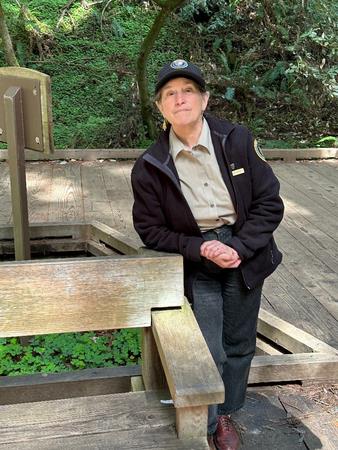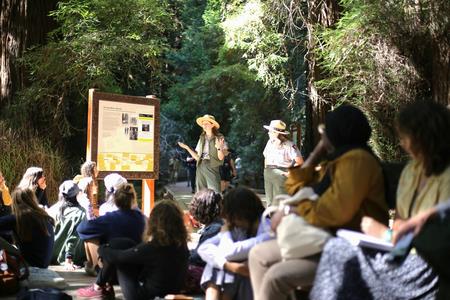
Mia, March 20. 2024
As a sequel to Heather Cassell's post yesterday, Mia Monroe sent this to me a bit later in the day. First, here are her subsequent comments about the post.
"somehow feel this web article will be noticed and disappear but if it is many hands then the stories, the effort, the significance will live on...also, saw Alison's alert and thought title should be tad more comprehensive to include impact to Native Americans (role of women, male racism...)"
Article
History Under Construction
Golden Gate National Recreation Area, Muir Woods National Monument

The role of the National Park Service is to preserve history - the good, the bad, the ugly, and everything in between. It’s not our job to judge what history is worth telling, but to share an accurate and comprehensive history. In this picture, Muir Woods rangers are discussing different historical narratives with a student group.
The facts are not “under construction,” but the way we tell history is.
When you think of history and how it is often taught, what concepts come to mind? In reflecting on this question with rangers, visitors to Muir Woods have often described history as static, definitive, and of a singular perspective. Our concept of the past reflects personal biases – the information we have learned and had affirmed through life experiences. History has typically been presented from the perspective of the dominant group in power and can, intentionally or not, exclude details that tell a more holistic story.
As park rangers, we are always learning about the sites we preserve. Our mission extends beyond recreation – the work we do is “for the enjoyment, education, and inspiration of this and future generations.” Research can unveil new information that challenges the conclusions we were previously confident in. We do active “construction” on the exhibits in the park, employing rigorous reevaluation to ensure they reflect up-to-date information and research. This reflective process is critical to understanding both our history and future; we invite you to apply this work in your own life, classroom, and community. While the facts or building blocks of history remain much the same over time, our perceptions of the past are constantly "under construction."
Who chooses how history is told?
There are many reasons why specific narratives aren’t shared. Sometimes, those telling the stories fail to consider perspectives outside their own. For example, the NPS employed few women and even fewer people of color from its founding in 1916 through the early 1960s. Unsurprisingly, early stories we shared reflect the biased perspective of a predominantly white, male workforce. As more people from different backgrounds became able to join the park service, their perspectives enriched the diversity of stories we share. For example, the research on women’s history at Muir Woods began in earnest in 2018 when a ranger asked herself, “was anyone else involved in this story?” Her findings laid the groundwork for our project researching how how women saved Muir Woods.
Other times, narratives challenge the way we see the world. This helps us expand our ideas about power, science, gender, race, and more.
For example, one of the most prominent figures in the founding of Muir Woods is William Kent. In the past, we shared a story of an uncomplicated champion of conservation. After all, he protected Muir Woods by donating it to the federal government. He also authored the legislation that established the National Park Service. However, this legacy is incomplete. During his public speeches running for Congress, he said, “We must exclude Asiatics... I wish it were possible to ship them all away.” In office, he pushed through policies that barred Asian immigrants from entering the country, owning land, and becoming US citizens. While he mobilized around preserving National Parks, he had a limited view of who should be welcome to experience them.
Another example comes in the connection between the eugenics movement and redwood conservation. Eugenicists believe that society should prevent some groups of people from having children. Most often, those targeted were people of color, those with disabilities, and members of lower classes. Not all early redwood conservationists supported the eugenics movement, but many of them did. Madison Grant and Theodore Roosevelt are two notable redwood conservationists with ties to the eugenics movement.
History Under Construction
Greg